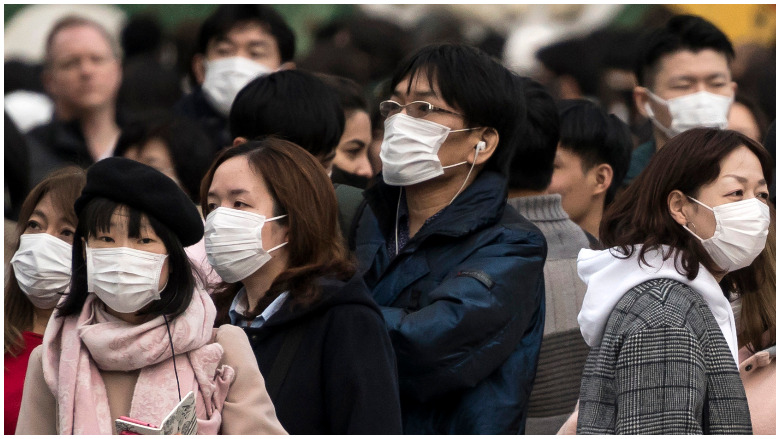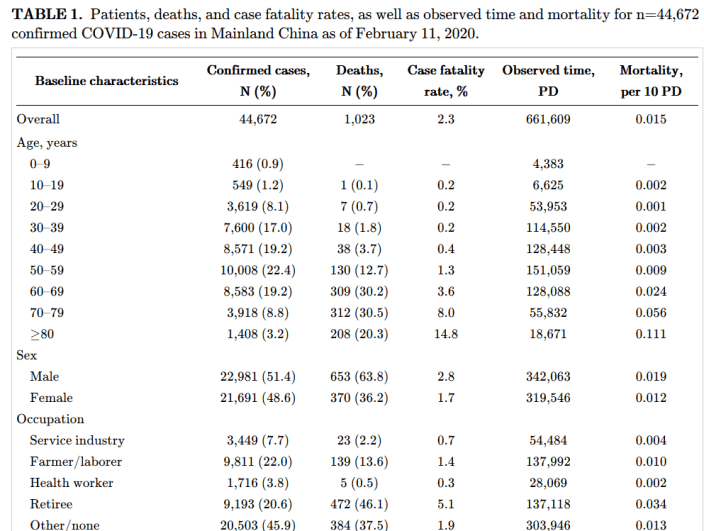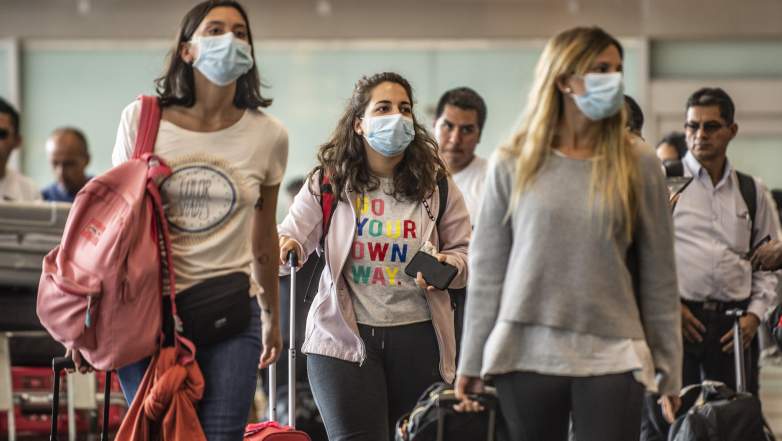
Coronavirus fears are flooding the world. However, what is the death rate for the virus? How bad is it, actually? If you get it, how likely are you to die? Is it more deadly than the flu?
The World Health Organization has calculated that 3.4% of the people worldwide with coronavirus have died. However, calculating death and mortality rates can be tricky business. That grew from an initial estimate of 2 percent.
There’s a big unknown here, though, and many believe it could push the death rate – especially the U.S. death rate – even lower. Testing. In the United States, the lack of widely available testing means that the death rate may be a lot lower. It’s simply not clear how many people are in the overall pool of infected – in other words, how many people are walking around with coronavirus but don’t die – because so few people have been tested. If many more people get coronavirus and are asymptomatic or suffer mild symptoms not requiring hospitalization, the death rate would clearly be lower.
Thus, the numbers were the best estimates authorities had, but they’re extrapolating them from known cases, which is a faulty premise. There’s no way to tell the overall pool. Thus, you can consider the estimates to be the ceiling.
In Germany, where there is widespread testing, the death rate for coronavirus is 0.74%.
To be sure, a lot of people die from the flu. WHO Director-General Dr Tedros Adhanom Ghebreyesus stated: “Globally, about 3.4% of reported COVID-19 cases have died. By comparison, seasonal flu generally kills far fewer than 1% of those infected.”
“Regarding the fatality rate, it appears that the risk of death after the pandemic coronavirus infection (estimated at 3% to 4%) is less than it was for SARS (11%) and MERS (35%), but may be higher than the risk from seasonal flu (0.1%),” Harvard Medical School reports. “However, the numbers circulating right now for this new coronavirus are likely to be adjusted over time, as more people are tested and reporting becomes more consistent.”
USA Today reports that, in the United States, flu has led to 12,000 to 61,000 deaths annually since 2010. So far this flu season, “there have been at least 34 million flu illnesses, 350,000 hospitalizations and 20,000 deaths from flu. At least 136 of those deaths were in children,” according to USA Today.
The New York Times reported that one calculation estimates 480,000 deaths from coronavirus. “Unlike with seasonal influenza, the entire population is thought to be susceptible to the new coronavirus,” The Times reports.
Of course, it’s not only about percentages; it’s also about scope and scale. If millions of people get it, a relatively small death rate can lead to a lot of deaths. Authorities are trying to delay the spread of the virus with social distancing strategies. According to The New York Times, experts say a worst-case scenario predicts between 160 million and 214 million people in the U.S. could test positive for coronavirus, in a situation that could spread out even for a year. “As many as 200,000 to 1.7 million people could die,” according to The Times.
Here’s a round up of coronavirus statistics that’s constantly updated.
Coronavirus has a higher death rate than the flu; it’s still in the single digits, but officials are clearly worried about widespread infection even into the millions. At that point, one major concern becomes the limited number of hospital beds to allow treatment for the percentage requiring hospitalization. The Times reports that there are only about 925,000 staffed hospital beds in the U.S. (and some are needed for other things.) But 2.4 million to 21 million people in the U.S. could require hospitalization.
Assessing the coronavirus death rate gets problematic because China, where the virus started, is notoriously untrustworthy when it comes to data that could make it look bad. It’s also impossible to get a base line because testing is so limited.
The Death Rate Varies By Demographic

CDC China Weekly
Coronavirus has a death rate that varies somewhat based on demographics. The China CDC Weekly reported the results of a major epidemiological study into this question. That study analyzed 72,314 patient records, including some that were suspected cases. It determined that coronavirus had an “overall case fatality rate of 2.3%.” The study was called Vital Surveillances: The Epidemiological Characteristics of an Outbreak of 2019 Novel Coronavirus Diseases (COVID-19) and it was conducted by the Novel Coronavirus Pneumonia Emergency Response Epidemiology Team.
However, USA Today, on March 13, 2020, put the death rate as higher; “Of the more than 127,000 people who have been infected worldwide, more than 4,700 have died. That’s a death rate of about 3.7%, and the WHO has previously estimated the rate at about 3.4%,” the newspaper reported.
The death rate in Italy is higher, at 5 percent, according to The New York Post, which explained this may be attributable to Italy’s aging population. In China, one study found the fatality rate to be 3.8 percent, but even higher in Wuhan.
“In an unfolding epidemic, it can be misleading to look at the naïve estimate of deaths so far divided by cases so far,” said Christl Donnelly, a disease specialist at Oxford University and Imperial College London, to Reuters. “This is due to the delay from the time it takes for individuals to progress from being diagnosed as cases to dying.”
The epidemiological study referenced above found that the death rate is higher for people over 80; for men; for retirees; people living in Hubei Province; and people suffering from other ailments, like hypertension, cancer, and diabetes.
The study further found the following:
…a total of 1,023 deaths have occurred among 44,672 confirmed cases for an overall case fatality rate of 2.3%. Additionally, these 1,023 deaths occurred during 661,609 PD of observed time, for a mortality rate of 0.015/10 PD.
The ≥80 age group had the highest case fatality rate of all age groups at 14.8%. Case fatality rate for males was 2.8% and for females was 1.7%. By occupation, patients who reported being retirees had the highest case fatality rate at 5.1%, and patients in Hubei Province had a >7-fold higher case fatality rate at 2.9% compared to patients in other provinces (0.4%). While patients who reported no comorbid conditions had a case fatality rate of 0.9%, patients with comorbid conditions had much higher rates—10.5% for those with cardiovascular disease, 7.3% for diabetes, 6.3% for chronic respiratory disease, 6.0% for hypertension, and 5.6% for cancer. Case fatality rate was also very high for cases categorized as critical at 49.0%.
According to a lengthy research report from the CDC, it’s formally called coronavirus disease 2019 (COVID-19) caused by the 2019 novel coronavirus (SARS-CoV-2). As most people know, the virus originated in Wuhan, Hubei Province, China in December 2019.
The death rate can vary slightly. BBC reported: “Researchers currently think that between five and 40 coronavirus cases in 1,000 will result in death, with a best guess of nine in 1,000 or about 1%.”
The disease spreads through respiratory transmission. “Person-to-person spread of COVID-19 appears to occur mainly by respiratory transmission. How easily the virus is transmitted between persons is currently unclear. Signs and symptoms of COVID-19 include fever, cough, and shortness of breath,” CDC reports.
Not everyone has an equal chance of succumbing to coronavirus. “Older adults and persons with underlying health conditions or compromised immune systems might be at greater risk for severe illness from this virus,” reports the CDC.
How Coronavirus Compares to the Flu

GettyPassengers walk while wearing protective masks, as a preventive measure regarding the COVID-19 virus, at Jorge Chavez International Airport, in Lima on February 27, 2020.
According to CDC, coronavirus and the flu share commonalities. “COVID-19 symptoms are similar to those of influenza (e.g., fever, cough, and shortness of breath), and the current outbreak is occurring during a time of year when respiratory illnesses from influenza and other viruses, including other coronaviruses that cause the ‘common cold,’ are highly prevalent,” the site reports.
BBC notes that it’s impossible to get a true mortality rate for the flu because “people with mild flu symptoms choose never to visit a doctor.”
What’s the death rate from the flu? How many people die from it? The CDC reports:
Deaths per 100,000 population: 2.0
(Some estimates give the case fatality rate with seasonal flu in the United States as less than 0.1%. Mortality rate for SARS was 10%, and for MERS 34%. The New York Times puts the death rate for flu at typically around 0.1% in the U.S., according to The New York Times. )
From October 1, 2019, through February 22, 2020, the CDC estimates there have been:
32,000,000 – 45,000,000
flu illnesses
14,000,000 – 21,000,000
flu medical visits
310,000 – 560,000
flu hospitalizations
18,000 – 46,000
flu deaths
“Flu is a contagious respiratory illness caused by influenza viruses that infect the nose, throat, and sometimes the lungs. It can cause mild to severe illness, and at times can lead to death. The best way to prevent flu is by getting a flu vaccine each year,” says CDC.
How widespread is the flu? “On average, about 8% of the U.S. population gets sick from flu each season, with a range of between 3% and 11%, depending on the season,” reports CDC. Children are mostly likely to get sick from the flu, with older adults less likely. However, people over age 65 and those under 5, as well as those with other ailments, are least likely to recover from flu.
READ NEXT: Coronavirus in Italy.